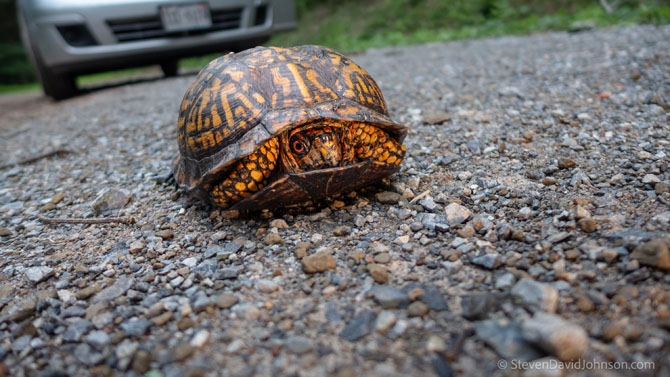
Photo by Steven David Johnson, Conservation Photography
Box turtles are “of greatest conservation need” in Virginia and vulnerable to vehicle collisions.
Three ways to reduce these collisions: influence driver behavior, influence animal behavior and separate animals from roads.
“You can recover costs [of building wildlife overpass or underpass] in two to four years, so it can be cost effective.”
— Dr. David Luther
Find Out More
Virginia Wildlife Corridor Action Plan https://dwr.virginia.gov/wp-content/uploads/media/Virginia-Wildlife-Corridor-Action-Plan.pdf
There are over one million vehicle-wildlife collisions in the United States every year, costing over $8 billion and tens of thousands of human injuries, GMU biology professor Dr. David Luther told Green Breakfast attendees in an online Sept. 14 talk titled “Zooming through Nature: the Wildlife Costs of Modern Transportation.”
And while human-wildlife conflicts are usually bad news, he said his talk would offer “some pessimism, sprinkled with optimism,” including “how we can be proactive and mitigate human-caused effects. This is not just Bambi sort of stuff,” he quipped.
A few Virginia statistics:
• Each deer collision costs around $41,000 to the state and to people.
• Black bear collisions are rising, numbered around 1,100 to 1,300 a year.
• 81,694 drivers crashed into wildlife crossing roads in 2022, making Virginia the ninth worst state for vehicle-wildlife collisions, according to State Farm insurance data.
A “Transportation Is Everywhere” slide mapped the world’s 54 million kilometers of roads, 1.2 million kilometers of railways and 1.4 million kilometers of shipping lanes, all of which can affect terrestrial and marine wildlife, from whales to lizards to snakes. Transportation systems worldwide adversely affect 2,311 vertebrate species of which 1,134 are globally threatened, he noted.
Solutions
Luther outlined three approaches that could reduce these collisions: influence driver behavior, influence animal behavior and separate animals from roads.
Three types of structures can help separate wildlife from roads: underpasses, viaducts and overpasses. He provided one local example, an underpass on the Fairfax County Parkway near U.S. 1.
Some animals are “choosy,” will use only a certain type. Deer, for example, use underpasses, but some animals avoid dark spaces. Others are reluctant to be exposed on overpasses.
Still structures like these are “win-wins” because they make roads safer, create connectivity corridors for animals and “help biodiversity and wildlife thrive,” he said.
A Virginia Department of Transportation study found, “When you do it right, you end up reducing animal-vehicle collisions by up to 90 percent.”
Luther added, “You can recover costs in two to four years, so it can be cost effective.”
Small Animals Too
Most reporting involves large animals like deer and bears, but smaller animals are at risk too. Many animals are hard wired to migrate and disperse.
Spotted salamanders, for example, breed in vernal pools in the spring and then move to forage in forests. They are small and slow and migrate at night, difficult for drivers to see. “Thousands get squished,” he said. The state built a salamander tunnel in Charlottesville so they can travel under a road.
In some places, wildlife can benefit from curvy roads that force drivers to slow down.
Flashing detection monitors signaling that an animal is near can help. Car manufacturers are “toying with options,” including alerting devices. Luther said that Teslas today can alert the driver if a pedestrian is near so perhaps vehicles will do the same for wildlife some day.
Virginia Is Acting
The Virginia General Assembly directed state agencies to prepare a wildlife corridor action plan to identify and reduce barriers to wildlife movement. The completed plan spotlights high quality habitats for priority species such as state- and federally-protected species and those at risk. It also identifies human barriers to wildlife movement and recommends wildlife crossing projects that could promote driver safety and habitat connectivity.
Luther listed 11 wildlife species designated by the state “of greatest conservation need” that are threatened by roads, including bog, wood, spotted and box turtles; timber rattlesnakes; eastern spotted skunk and fishers (members of the weasel family). Of the 11, the wood, box and spotted turtles are most commonly seen in Northern Virginia.
Transportation systems also fragment and disconnect habitat and create noise and chemical pollution.
Luther challenged: “We can reduce collisions and provide economic and ecological benefits. Virginia is proactively attending to this issue for both people and wildlife. Our natural heritage is ours to take care of.”
This monthly breakfast is sponsored by the Northern Virginia Soil and Water Conservation District.
